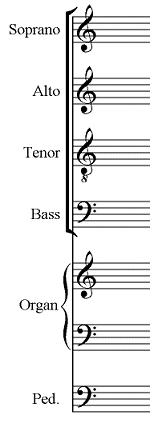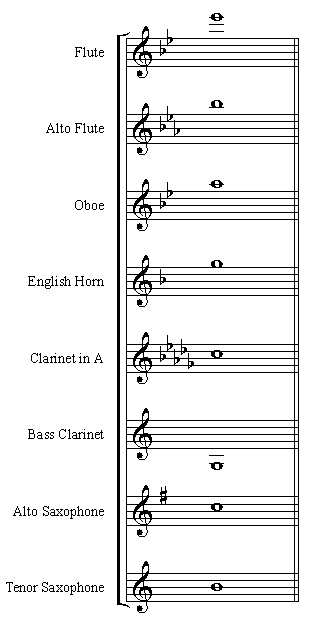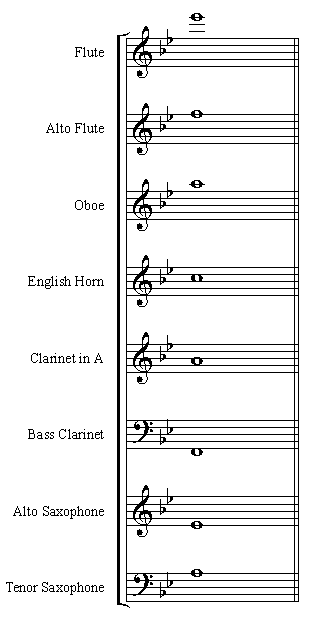Tuned percussion parts use a five line stave. Some instruments, e.g. marimbas and harps, use a keyboard layout. Untuned percussion (the four lines at the top of the score below) may use the five line stave with standard note-heads (where each line or space refers to a different untuned percussion instrument in a set) or a single line with a special clef sign and note heads in the form of small x's, a symbol used to show a note of no predetermined pitch on one particular untuned percussion instrument.
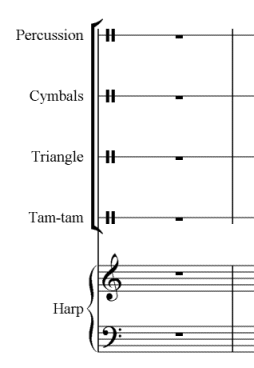
How to Write Parts for Transposing Instruments :: 
In many modern works, transposing instruments, that is those where the player reads one note but produces a different note, may be written, in the score, as they are heard rather than as they are read. The individual parts, however, would still be set out with the standard transposition. By notating the whole score at concert pitch, give or take octave transpositions, it is much easier to 'see' the harmonic and melodic detail. Pre-20th century scores are written with the transposing parts as they are read.
Transposed parts are commonly used for brass and some woodwind instruments.
These are some examples of transposing instruments:
Bb trumpet
French horn (F)
Alto saxophone (Eb)
Tenor saxophone (Bb)
Cor anglais (F)
Bb clarinet
A clarinet
Before writing for a transposing instrument you need to know its key, any octave shifts in the transposition and the clef the player expects to read.
One example shows their advantage. Clarinets come in different sizes but all have the same fingering system. If a player reads a part that prompts for the fingering rather than for the note, changing between instruments is much easier. So what happens is this. All clarinet parts read as though the bottom note is C. This is the note both a B flat and an A clarinet player will read. However, the former produces a B flat while the latter produces an A. If the part is transposed relative to instruments that play what they read, the correct note is heard. The same convention is used by brass players so that, as one moves from one member of the brass instrument family to another, one is using only one note read - fingering convention. The way the part is transposed takes care of the fingering - note heard relationship.
So, what is the correct recipe? Let us write a transposed part for Bb trumpet, that is, a part the trumpet will play from.
The Bb trumpet part is transposed a whole tone above concert/sounding pitch. So if the composer/arranger wants the trumpet to sound a B flat he or she must write a C in the trumpet player's part. Let us begin with a concert/sounding pitch part in the full score and produce a part for the trumpeter to play from, i.e. a transposed part.
First remember to transpose the key signature up a tone above concert/sounding pitch. Note: the key signature is that one tone higher than the key signature shown in on the concert/sounding pitch line in the score.
Eb concert transposes up one tone to F (i.e. Eb + one semitone = E; E + one semitone = F)
C concert transposes up one tone to D (i.e. C + one semitone = C#; C# + one semitone = D)
D concert transposes up one tones to E (i.e. D + one semitone = D#; D# + one semitone = E)
and so on ....
One can write out a table to help keep track of the correct adjustment.
| Concert part - sounds key/note | Eb | F | G | Ab | Bb | C | D | Eb |
| Transposing part - reads key/note | F | G | A | Bb | C | D | E | F |
We can examine another example, the baritone saxophone which is scored in the full score in bass clef but whose extracted transposing part is written up a diatonic 13th (diatonic 6th and an octave) to the treble clef.
First one raises the part in the bass clef by one octave, then by a further 6th and final converts the final line into treble clef. Note: don't forget to adjust the key signature too. As with the trumpet part above, it helps to set out a table showing the concert/sounding key and the note up to which it must be transposed on the player's part.
| Concert part - sounds key/note | C | D | E | F | G | A | B | C |
| Transposing part - reads key/note | A | B | C# | D | E | F# | G# | A |
Let us summarise what we have said above by showing below an example of how a chord might be written in a score and what notes the listener would actually hear in each case. The only non-transposing instruments are the flute and the oboe.
|
|
One of our readers asked an interesting question. "I have a B flat clarinet part that I would like to play on a clarinet in A. How do I transpose the part so that the notes my instrument sounds reproduce the notes the B flat clarinet sounded on the original transposed part?".
Let us review how the parts for B flat and A clarinets are written. Earlier we wrote: "All clarinet parts read as though the bottom note is C. This is the note both a B flat and an A clarinet player will read. However, the former produces a B flat while the latter produces an A. If the part is transposed relative to instruments that play what they read, the correct note is heard."
The key to solving our reader's question lies in the way the transposing parts for these two instruments are written. To play the note C in C major, a B flat clarinet part notates a B flat in a part bearing a key signature with 2 flats, the key signature for B flat major while an A clarinet part notates an A in a part bearing a key signature with 3 sharps, the key signature for A major. So we know that a B flat in a B flat clarinet part has to be rewritten as an A, a semitone (half step) lower, in an A clarinet part and the key signature has to be changed from two flats to three sharps, equivalent to adding five sharps to the original key signature (two sharps cancel the two flats, plus a further three sharps to establish the new key). This gives us our 'recipe'.
Were we moving the other way (from a part for clarinet in A to a part for clarinet in B flat), the shifts would be the reverse, the part would be written one semitone higher and the key signature would be shifted by the equivalent of 5 flats.
An additional question is what should one do when creating a transposed score (or extracting transposed parts) of an atonal piece which is notated without key signatures. Should transposing instruments have key signatures (which put them into concert C)? The best convention (which is set out on the Music Notation Questions Answered web page) suggests that such parts, whether in a score or individual, should be notated transposed but without a key signature. The presence of a key signature would at best be misleading since the piece is not actually in any particular key.
Chart of Transposing Instruments :: 
| instrument | key | written range (as 'read') middle C is C4 | note shift from 'read' to 'heard' (in semitones) e.g. +12 means note heard is one octave higher than note read | concert range (as 'heard') middle C is C4 |
| piano | C | A0 - C8 | 0 | A0 - C8 |
| vibraphone | C | F3 - F6 | 0 | F3 - F6 |
| guitar | C | E3 - C6 | 0 | E3 - C6 |
| violin, viola, cello | C | 0 | ||
| double bass string bass | C | E2 - E5 | -12 | E1 - E4 |
| piccolo | C | C4 - C7 | +12 | C5 - C8 |
| concert flute | C | C4 - C7 | 0 | C4 - C7 |
| alto flute | G | C4 - C7 | -5 | G3 - G6 |
| bass flute | C | C4 - C6 | -12 | C3 - C5 |
| oboe | C | Bb3 - A6 | 0 | Bb3 - A6 |
| oboe d'amore | A | Bb3 - E6 | -3 | G3 - C#6 |
| cor anglais English horn | F | B3 - F6 | -7 | E3 - Bb5 |
| piccolo clarinet | Ab | E3 - E6 | +8 | C4 - C7 |
| piccolo clarinet | Eb | E3 - G6 | +3 | G3 - Bb6 |
| piccolo clarinet | D | E3 - G#6 | +2 | F#3 - Bb6 |
| clarinet | Bb | E3 - B6 | -2 | D3 - A6 |
| clarinet | A | E3 - B6 | -3 | Db3 - Ab6 |
| alto clarinet | Eb | E3 - G6 | -9 | G3 - Bb5 |
| bass clarinet | Bb | E3 - G6 | -14 | D3 - F5 |
| contrabass clarinet | Eb | E3 - D6 | -21 | G1 - F4 |
| contrabass clarinet | Bb | E3 - D6 | -26 | D1 - C4 |
| bassoon | C | Bb1 - Eb5 | 0 | Bb1 - Eb5 |
| contrabassoon | C | Bb1 - Bb4 | -12 | Bb0 - Bb3 |
| sopranino saxophone | Eb | Bb3 - Eb6 | +3 | Db4 - Gb6 |
| soprano saxophone | Bb | Bb3 - F#6 | -2 | Ab3 - E6 |
| alto saxophone | Eb | Bb3 - F#6 | -9 | Db3 - A5 |
| tenor saxophone | Bb | Bb3 - F#6 | -14 | Ab2 - E5 |
| baritone saxophone | Eb | A3 - F#6 | -21 | C1 - Gb4 |
| bass saxophone | Bb | Bb3 - Eb6 | -26 | Ab1 - Db4 |
| French horn | F | F2 - C6 | -7 | Bb1 - F5 |
| piccolo trumpet | D | F#3 - C6 | +2 | G#3 - D6 |
| trumpet | Bb | F#3 - G6 | -2 | E3 - F6 |
| cornet | Bb | F#3 - C6 | -2 | G3 - Bb5 |
| Flügelhorn | Bb | F#3 - C6 | -2 | G3 - Bb5 |
| alto trombone | E | A2 - F5 | 0 | A2 - F5 |
| tenor trombone | Bb | E2 - Db5 | 0 | E2 - Db5 |
| bass trombone | F | Bb1 - Gb4 | 0 | Bb1 - Gb4 |
Many older pieces for horn were written for a horn not keyed in F as is standard today. As a result a requirement for modern orchestra hornists is to be able to read music directly in these keys. This is most commonly done by transposing the music on the fly into F. A reliable way to transpose is to liken the written notes (which rarely deviate from written C,D,E, and G) to their counterparts in the scale the F horn will be playing in.
| commonly seen French horn transpositions include: | |
| Bb alto (in German, indicated as B) | up a perfect fourth |
| A alto | up a major third |
| G | up a major second |
| E | down a minor second |
| Eb | down a major second |
| D | down a minor third |
| C | down a perfect fourth |
| Bb basso (in German indicated as B) | down a perfect fifth |
| Some less common transpositions include: | |
| Ab alto | up a minor third |
| Gb | up a minor second |
| Db | down a major third (used in some works by Berlioz, Verdi and Strauss (Der Rosenkavalier)) |
| B (in German indicated as H) | down a tritone (used by Brahms) |
| A basso | down a minor sixth (used in some works by Verdi) |
| Ab basso | down a major sixth (used in some works by Verdi) |
| G basso | up a minor seventh (used in some works by Verdi) |
Reference:
Sounding Range of Orchestral Instruments :: 
We show the approximate sounding ranges of the main orchestral instruments below.
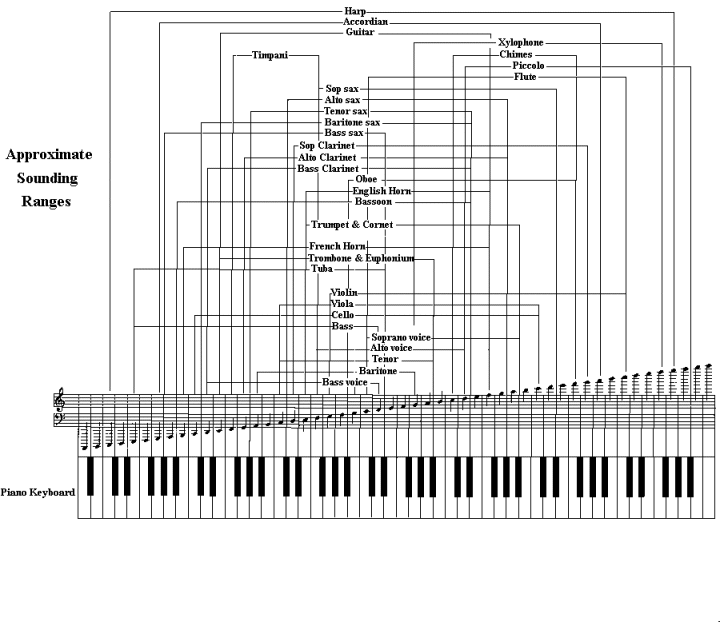
We have provide more complete information in lesson 29.
You will find examples of transposing parts in the scores listed under instrumental ensembles.
These scores show the range of material that can be set in score and played back using the Scorch plug-in.
Music for Jazz Orchestra - Sketches by James Humberstone (1998)
Fanfare 2000
Caminhada by Carlos Oliviera
Concerto for Orchestra by David Eccott
Maximum Underground by Stephen Taylor
Orchestral Rock by Cliff Turner
Fantoches by Claude Debussy arranged for clarinet and string orchestra by David Stowell
Brass Odyssey for brass band by Derek Bourgeois
Roller Coaster for windband by Derek Bourgeois
A Dorset Celebration for orchestra by Derek Bourgeois
Red Dragon for windband by Derek Bourgeois
Green Dragon for windband by Derek Bourgeois
Biffo's March for windband by Derek Bourgeois
Exterior by F.T. Nordensten
Metro Gnome by Derek Bourgeois
Prelude and Fugue No. 1 by Glen Shannon
Laughing Stock by Francisco del Gil Valencia
Flute Piece by Chris Walker
The Minute Waltz by F. Chopin
Deuxičme Arabesque by C. Debussy
Dolmetsch Library e-Music Scores
